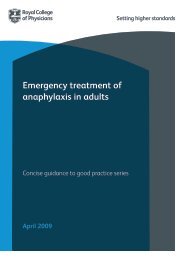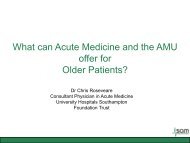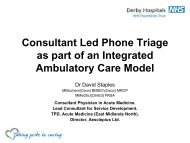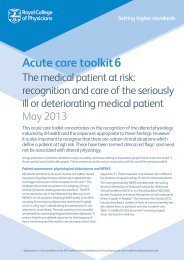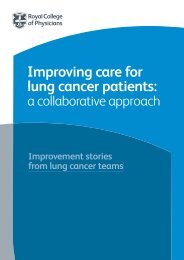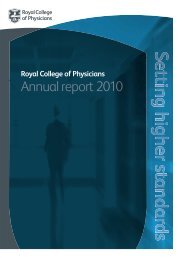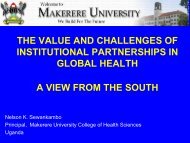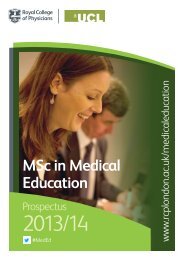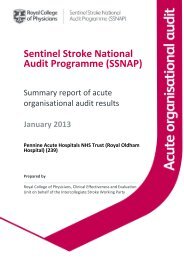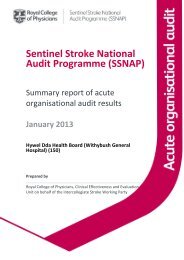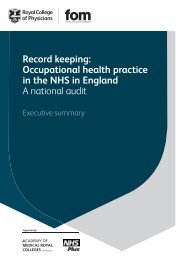Consultant physicians working with patients 5th edition - FSEM
Consultant physicians working with patients 5th edition - FSEM
Consultant physicians working with patients 5th edition - FSEM
Create successful ePaper yourself
Turn your PDF publications into a flip-book with our unique Google optimized e-Paper software.
<strong>Consultant</strong> <strong>physicians</strong> <strong>working</strong> <strong>with</strong> <strong>patients</strong><br />
for nearly all bar consultants. It is interesting to note the<br />
impact this has had on consultants such that in the last<br />
census, 21 59% reported that they were having to do jobs<br />
that would have previously been done by junior doctors.<br />
At the time of writing there are also plans to radically<br />
change the structure of the NHS in England <strong>with</strong><br />
respect to commissioning of specialist services, locally<br />
plan workforce requirements and thus local training<br />
requirements. Together <strong>with</strong> the huge savings that are<br />
needed over the next three years, the medical specialty<br />
workforce will also face considerable difficulties in the<br />
next few years.<br />
Within the next few years the UK will, for the first time,<br />
become self-sufficient for medical graduates. With this<br />
comes the ability to fulfil the aspirations of achieving a<br />
world-class NHS <strong>with</strong> a highly trained and motivated<br />
medical workforce.<br />
The future medical service will be consultant delivered<br />
rather than consultant led. In some of the very acute<br />
specialties this raises the possibility of full shift <strong>working</strong><br />
and round-the-clock presence of a consultant. This is<br />
because consultant-delivered care is better for <strong>patients</strong><br />
and the hours worked by junior doctors are reducing<br />
substantially as a result of the EWTD and new training<br />
requirements for doctors in training. The EWTD<br />
reduced the <strong>working</strong> week of the junior doctor from<br />
56 hours to 48 hours in 2009. There is a requirement<br />
now for more structured teaching programmes for<br />
doctors in training, <strong>with</strong> four hours protected teaching<br />
time each week and additional time for formal<br />
assessment and feedback, which takes a further hour of<br />
both the junior doctor and the consultant. The New<br />
DealwasnegotiatedbytheBMAtogiveadequaterest<br />
time for junior doctors and to structure rotas around<br />
the 56-hour <strong>working</strong> week. The rotas are now 48 hours<br />
aweek.<br />
The consequence of these reductions of junior doctors’<br />
hours of work has been that they are less in evidence<br />
during the day and at night. The result of these changes<br />
has been a gradual erosion of the consultant-led team of<br />
junior medical staff. This has had effects on access to<br />
training and to continuity of care for <strong>patients</strong>. One<br />
particular concern is that the wards during the day may<br />
not have adequate junior doctor cover, if the junior<br />
medical staff are on nights rotas at that time. There are<br />
moves to renegotiate the New Deal, to increase<br />
flexibility. There are also discussions in Europe about<br />
changing the application of the EWTD to junior<br />
10<br />
doctors. No one wants to see a return to fatigued junior<br />
doctors <strong>working</strong> very long hours, but delivering training<br />
and good-quality patient care is proving to be very<br />
difficult <strong>with</strong> the current inflexible arrangements about<br />
hours of work.<br />
Moves to community care and the development of<br />
‘Teams <strong>with</strong>out walls’, 22 which encompasses new<br />
relationships between specialists and GPs, will probably<br />
require more and not less specialists coupled <strong>with</strong> new<br />
contractual arrangements.<br />
There is also an increased need to be aware of the health<br />
of a local population and the incidence and prevalence<br />
of particular diseases to best plan patient pathways<br />
involving primary care and specialist care, as well as<br />
public health medicine.<br />
Changing delivery of medical care<br />
The delivery of acute medical care has gradually<br />
changed. The new specialty of acute medicine is<br />
providing more of this service. The traditional role of<br />
the consultant general physician in acute medicine has<br />
reduced in recent years. However, the rising number of<br />
medical admissions and the increasing number of frail<br />
older people <strong>with</strong> a number of different conditions<br />
means we have to think seriously about the best way to<br />
care for the acutely ill medical patient and the best<br />
balance between specialists and general <strong>physicians</strong> <strong>with</strong><br />
an interest in a specialty.<br />
There is also a need for more specialist centres to give<br />
highly specialised care to a population, eg thrombolysis<br />
in stroke, because every hospital dealing <strong>with</strong> acute<br />
medical admissions may not give this treatment. As<br />
technology advances, there are merits in grouping<br />
expertise together in specialised centres which cover a<br />
bigger population than a local hospital. These<br />
developments may drive the need for reconfiguration of<br />
hospitals.<br />
Working <strong>with</strong> <strong>patients</strong><br />
Patients, relatives and carers are knowledgeable. They<br />
ask questions, and expect and require answers. They<br />
want to be more involved in making decisions about the<br />
pattern of their care. Many now communicate <strong>with</strong><br />
their doctors by text and email, asking questions derived<br />
from internet searches. The doctor–patient relationship<br />
C○ Royal College of Physicians 2011



